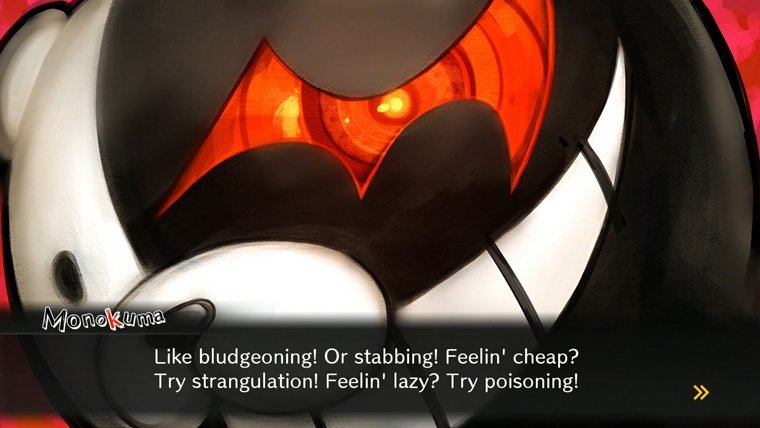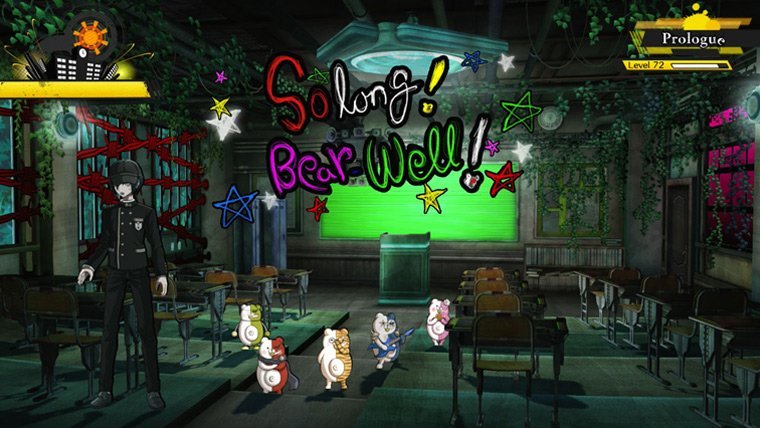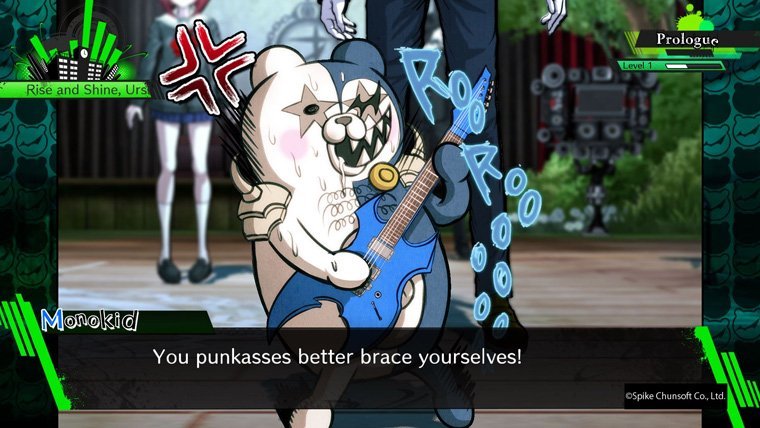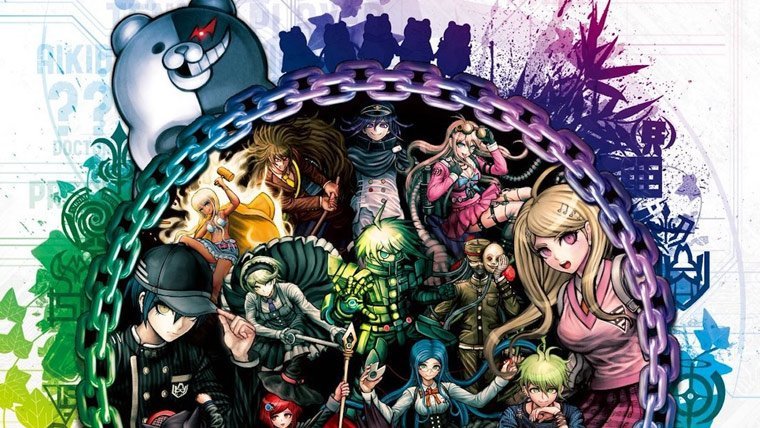Every once in a while there is a videogame that it becomes much more than the simple sum of its parts. The full construction adquires additional meanings, significance and power to affect players on an emotional and intellectual level. These are titles that excel at gameplay, level design, story, or character writing, and then, when experienced together as a whole, they manage to imprint an unforgettable memory on the player. Spike Chunsoft has achieved this feat with Danganronpa V3: Killing Harmony.
As a brief introduction, Danganronpa is a videogame series that mixes genres like visual novel, adventure in first person, and puzzles and minigames. The basic premise throughout the three main entries is that a group of high school students awake trapped at an education center with limited recollection of their previous life. With barely any time to feel confused, the principal of the school announces that he is forcing the students to participate in a macabre ‘killing game.’ However, there is a reward reserved for the winner that will make more than one person take willingly part in the plan: The person who kills one of their classmates and is not exposed by the rest will gain the privilege to leave the school. The rest of the group will be killed as punishment.
There are risks, though: If the culprit is correctly revealed, they will be the ones to be executed, while the other students just continue to live another day, when another murder might happen. This sets the main structure of each chapter in the games, with most of them repeating the same pattern of Introduction > Free Time > Murder > Investigation > Class Trial.
If the culprit is correctly revealed, they will be the ones to be executed
While this premise might certainly paint a bleak reality, Danganronpa gets away with presenting the most gruesome situations by shocking the audience with a gleeful package. For example, while any other fiction would portray the school’s principal as a grim person, here the main villain is a cute cartoon teddy bear that you would want to hug…if only he wasn’t forcing you to kill your friends.
Each entry in the series has resorted to this kind of shock value to get away with the most unimaginable horrors, but Danganronpa V3 manages to outperform its predecessors by touching upon every topic and situation that would be seriously off-limits in every other fiction and still come out reasonably victorious by finding the ironic or ridiculous side in them.

When you check out the age rate on the cover of the game, trust that it is correctly warning you that this is a game for exclusively mature audiences. Have you seen some gruesome scenes in other games? V3 can easily match them. You think that bonus love interests and sex minigames are cute? V3 features extra love scenes with every single character, plus erotic situations, and even an actual incest storyline. Other games have foul language? V3 has the filthiest insults I have ever heard in my life, and I have even discovered ways to make the ones that I know much worse.
V3 is a constant, overwhelming surprise that leaves a permanent mark in your mind
The key here is that those moments are supported by a very smart writing that knows how to use the most inappropriate terms in a way that makes them appropriate in each particular situation. Not only the dialogue is full of creative expressions on their own, but it also holds the most irreverent references to the series itself, like when Monokuma points out how short the prologue of the games used to be when he wasn’t sharing screen time with his five kids. Or even references to other properties like Resident Evil, Sonic, and even Death Note or Doraemon.
And it’s not just the topics, visuals, or the language. V3 is *designed* to shock the audience. From the revelation at the end of chapter 1 that plays with story elements in a way very few games dare to do, to the final act that obliterates meta conventions and the fourth wall, V3 is a constant, overwhelming surprise that leaves a permanent mark in your mind.
And part of the formula to take the audience unprepared for the next twist is to keep switching the source from that shock. You never know whether is going to be a new plot, a character trait, or a brand new gameplay mechanic that is going to make you see the adventure with a new perspective from that point on, but it is very unlikely that you can foresee what is coming. And even if you get suspicious about a coming twist, the game still has five more prepared for the next hour.

Of course, this would not be possible if each of those aspects didn’t engage the player into keep discovering what else they have to offer. The ever-diminishing character roster, for example, keeps evolving into a more complex version from their original introductions that not only helps seeing them in a warmer light, but also affects the development of their comrades, resulting in a group that by the end of the game have established strong bonds between them and with the player. It is not just only a welcome feature, but also one that is pretty much required considering that without this depth obtained, part of the roster would feel a constant annoyance and a hurdle in order to experience the story.
This is one of the situations where the end result can overwhelmingly overcome a merely-solid start. Most players will be very surprised by how attached they have grown of the group by the final chapters, considering that they don’t seem that engaging in the first moments of the adventure. How do they fare compared to the cast from previous games? While V3 doesn’t introduce any truly original character type that we haven’t seen before in some form, it is fair to say that at least the new cast is able to match iconic characters like Kyoko from D1 or the relationship between Hajime and Chiaki in D2. V3’s protagonist Kaede stands out from her predecessors by being more quirky and have a stronger personality.
The series’ icon Monokuma remains as delightfully wicked as usual
The series’ icon Monokuma remains as delightfully wicked as usual, and this time he comes accompanied by five little bears known as the Monokubs, who are supposed to be his children. They are a fun addition to the cast, and some like Monodam will even become fan favourites, but the only issue here is that they lack the same menacing presence of their dad, making the first couple of chapters have a less oppressing atmosphere than usual. This is caused by the volume of screen time that they take, which in the past was exclusively reserved for their father as the only villain in the adventure.
V3 attempts to recreate the unforgettable ambiguity of D2’s Nagito with Kokichi, a compulsive liar and Ultimate Secret Organization Leader who will give us more than one headache with his constant change of allegiances and recollection of events. In fact, Kokichi personifies one of the main themes of the game, which is the lies and the things that truly matter when you can’t be sure of the information you receive. Moments of true disbelief only happen a few times for the first part of the adventure, but once we cross the equinox of the story and we approach the end we will not be sure of who we can trust or even what the game is about anymore.

The theme of lies is not only present in the story, but it’s also part of the gameplay, as one of the main new features of the class trials is the ability to make a false statement in order to guide the conversation in a new direction. The way this is performed is by finding the statement that is blocking the investigation at that moment and break it with the opposite version of one of our Truth Bullets, which is obtained by keeping the triangle button pressed before shooting. This doesn’t necessarily improve the ‘Non-Stop Debates’ technically speaking, and it’s more a way to increase the difficulty more than a truly meaningful addition.
The rest of Class Trial minigames follow the same pattern of previous entries, although they all have been modified to some degree. The new Mass Panic Debates as similar to the regular Non-Stop variation, only that they consist on a three-way discussion in which one of the characters can block the others’ weak spots by raising his or her voice. D2’s Logic Dive has been transformed in the more cheeky Psyche Taxi, in which players drive a car and collect letters to form questions, and pick up a female escort holding the right answer. But be careful! because if you choose the wrong girl, the screen will be covered in pink blood.
Other brand new additions are the Mind Mine, a nice puzzle minigame consisting on removing blocks in order to reveal an image representing the right answer, and the Argument Armament, which is a rhythmic battle with the main adversary at the end of the trial, and will make things really hard for us in the higher difficulties.
The star of V3’s Class Trials are the thrilling Debate Scrums
But the star of V3’s Class Trials are the thrilling Debate Scrums. Those happen when the participants are locked in a split debate. Then they are divided in two groups, with each character making a statement of a particular topic that we’ll have to link with one of the members of our team. It’s not only a fun segment, but it also features one of the best introductions and soundtracks of the trial.
Masafumi Takada’s music for the game retains the distinctive mix of jazz and electronic sounds, adding a touch of blues to the main theme, and a more relaxed vibe overall to some moments that were more haunting in previous games, like the murder investigations. Rise and Shine Ursine (The Monokubs Theme) stands out as the more original and unique of the new original tracks, similar to what the Monomi’s Theme meant for the soundtrack of D2.
Individually, all of these aspects work well on their own. It’s how they support each other and how they grow exponentially over time what makes Danganronpa V3 an unforgettable experience. This is actually a signature trend in the series, that makes you incapable of being truly ready to state an opinion on a game until you have gone through the complete duration of the story.

Ever since its Japanese release in January, online forums have been full of speculation on the supposedly shocking finale twist, which is a lot considering that D2’s ending revelation was already brutal. Is it really worth of this attention? After going through the whole adventure I can say that yes, it is, because not only makes you reconsider your perspective on the events up to that point – a tradition in the series – but it also dramatically transforms the canon of the franchise, opening a new and unexpected set of directions that the story could take in the future.
Does this mean that Danganronpa V3 is a good starting point for newcomers? In one way yes because the game can be perfectly enjoyed separately from the others, but on another, they will get crucial details on the story of D1 and D2 completely spoiled, ruining the surprise to someone who might want to play them afterwards. There is also the fact that after so many twists of massive proportions on V3, the ones from previous games don’t seem so huge anymore, lessening their impact and affecting the enjoyment of someone who goes through those games for the first time.
One could also argue that V3 feels so shocking precisely because it feeds on the preconceptions built by playing the series up to this point to then crush them in the most brutal way. In this sense, series writer Kazutaka Kodaka is saying goodbye to the franchise clearly stating what direction should take the universe in the future.
The Verdict
Groundbreaking, unforgettable, unique, hilarious, smart, outrageous…there are many words to describe Danganronpa V3: Killing Harmony, and none of them have to do with mediocrity. Spike Chunsoft has defied expectations with a game that reaches the highest standards in entertainment and comedy, and even introduces a volume of philosophic conversations like very few titles have done in decades. At this point, one starts to question what else does Monokuma have to do to become the worldwide sensation it is destined to be.











Published: Oct 6, 2017 03:27 pm